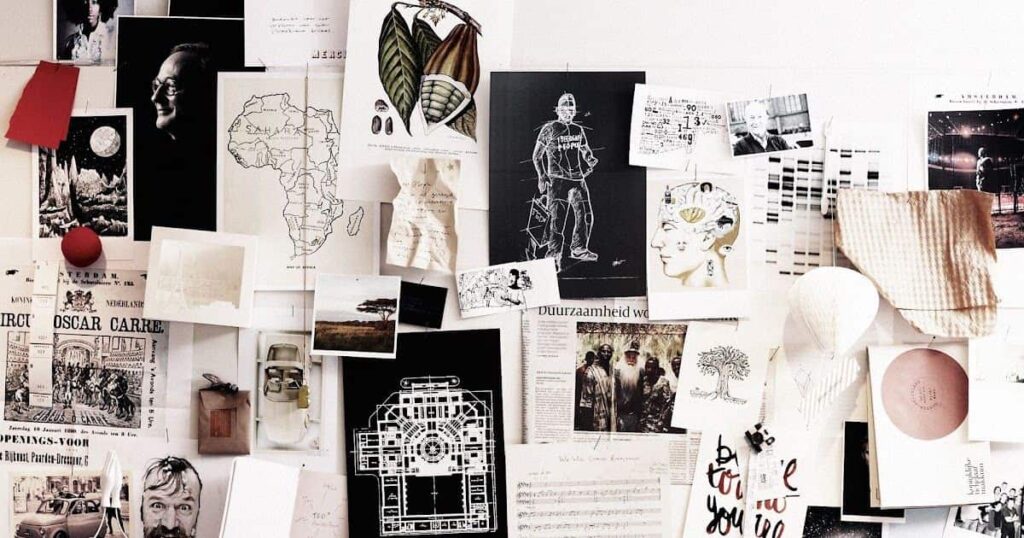Collage making is a fascinating art form that allows individuals to express themselves by assembling various elements into a single, cohesive creation.
This technique, rooted in centuries-old traditions, has evolved into a modern creative practice that combines visual storytelling and artistic exploration.
At its core, a collage is a composition created by layering different materials, such as paper, fabric, photographs and found objects. These elements are often arranged in innovative ways to convey themes, emotions or narratives. The beauty of collage making lies in its accessibility; anyone can engage in it, regardless of skill level, using materials readily available at home or through recycling.
A Platform for Expression
Collages can take many forms, from abstract arrangements to figurative depictions of real-life scenarios. The process often begins with gathering inspiration and materials. Artists and hobbyists might explore magazines, old photographs, or natural textures to find pieces that resonate with their vision.
Collage making also serves as a therapeutic outlet, offering individuals a means to explore their thoughts and emotions. The tactile experience of cutting, tearing, and gluing can be both meditative and invigorating, helping people channel their creativity in meaningful ways.
Techniques and Tips for Beginners
- Start Simple: Begin with basic materials like colored paper, glue and scissors. As confidence grows, experiment with paints, inks and textured surfaces.
- Plan Your Layout: Before gluing materials down, arrange them to see how they interact. Play with contrast, alignment and balance to achieve your desired effect.
- Embrace Imperfection: Collage making thrives on spontaneity and experimentation. There’s no right or wrong, let the process guide you.
Endless Possibilities
Whether you’re creating a personal vision board, a family scrapbook or a piece of fine art, collage making offers infinite possibilities. It encourages creativity, resourcefulness and the reimagining of everyday materials into something extraordinary.
Engaging in collage making not only enhances artistic skills but also promotes mindfulness and a deeper appreciation for the world around us. It is a timeless practice that continues to inspire people of all ages and backgrounds.
The History of Collage Art

Collage art traces its origins back to the early 20th century in Europe. The term “collage” comes from the French word coller, meaning “to glue.” Initially, it emerged as a groundbreaking technique in the modern art movement.
Key Historical Moments
- Cubist Pioneers: Pablo Picasso and Georges Braque introduced collage into the fine arts during their Cubist phase.
- Dada Influence: During World War I, Dada artists like Hannah Höch used collage to challenge traditional notions of art.
- Digital Revolution: In the 21st century, digital collages have expanded possibilities for artists globally.
“Collage is a powerful medium for exploring reality through fragments,” remarked artist Richard Hamilton, a pioneer in pop art.
NOTE: You may also like to read about Emma Watson’s Best Photos. Hope you will like this article.
Why Collage Making is a Unique Form of Expression
Collage art stands out because of its unparalleled flexibility. Unlike traditional forms, it doesn’t adhere to strict rules, allowing endless creative freedom.
What Makes It Special?
- Layered Storytelling: Each piece can symbolize a different idea or memory.
- Material Diversity: Anything from newspapers to fabric can become art.
- Personal Touch: Each collage reflects the artist’s perspective, making it deeply personal.
Case Study:
Jane, an artist from the UK, uses collage making to depict her life’s journey. Each material she selects represents different emotions, creating a visual diary that resonates globally.
Essential Tools and Materials for Collage Making
Creating a stunning collage doesn’t require expensive tools. Here’s a handy checklist:
Basic Supplies:
- Scissors or craft knives
- Adhesives (glue sticks, mod podge)
- Various papers (magazines, old books, colored sheets)
Advanced Tools:
- Precision cutting tools
- Acrylic gels for texture
- Digital software for virtual collages
Comparison Table:
| Tool Type | Examples | Uses |
| Cutting Tools | Scissors, X-Acto knives | Cutting precise shapes |
| Adhesives | Glue, mod podge | Fixing materials together |
| Digital Software | Adobe Photoshop, Canva | Creating digital collages |
Techniques to Master in Collage Art

Collage techniques vary widely, but mastering these foundational methods can elevate your creations:
Layering and Composition
- Arrange materials to create depth. Overlapping elements add dimension.
Texture Creation
- Combine different materials like fabric, paper and even metal to enhance tactile quality.
Color Coordination
- Use complementary colors to create harmony. Experiment with contrasts for bold statements.
Quick Tips
- Tear vs. Cut: Torn edges give a raw, organic feel, while clean cuts look polished.
- Balance: Distribute visual weight evenly for an aesthetically pleasing piece.
Inspiring Themes for Your Next Collage Project
Choosing a theme can provide direction and inspiration. Here are some ideas:
- Nature
Capture landscapes, animals or seasons using organic materials like leaves.
- Personal Memories
Create a collage using photos, letters and keepsakes. This can serve as a memory board.
- Social Commentary
Reflect on societal issues by integrating newspaper clippings and symbolic imagery.
Example Project:
A London-based artist created a collage highlighting climate change using recycled materials. Each layer represented a different environmental issue.
Famous Collage Artists and Their Contributions

- Hannah Höch:
A pioneer in the Dada movement, known for politically charged collages. - Richard Hamilton:
Credited with creating the first pop art collage, “Just what is it that makes today’s homes so different, so appealing?” - Modern Influences:
Contemporary artists like Kara Walker blend historical and modern elements to provoke thought.
Explore More: Visit online galleries showcasing works by these artists for inspiration.
The Benefits of Collage Making for Mental Health
Collage making isn’t just about art, it’s also therapeutic.
Benefits:
- Stress Relief: Focused, repetitive actions can be calming.
- Mindfulness: Helps you stay present and engaged.
- Self-Discovery: Creating collages encourages introspection.
Anecdote: Sarah, an artist from New York, used collage therapy to overcome anxiety, finding solace in arranging colors and textures.
FAQ’s
What materials can I use for collage making?
You can use paper, fabric, photos, magazines and even recycled materials.
Is collage making suitable for beginners?
Yes, collage making is beginner-friendly and requires minimal tools.
Can collage art be digital?
Absolutely! Many artists use software like Photoshop to create digital collages.
How does collage making benefit mental health?
It promotes mindfulness, reduces stress and encourages creative expression.
Conclusion
Collage making offers endless possibilities for creativity and personal expression. It’s more than just an art form, it’s a powerful medium to tell stories, explore ideas and even heal.
Ready to create your masterpiece? Gather some materials, let your imagination flow, and start your journey into the art and creativity of collage making.

I am experienced with over four years of expertise, specializing in multi-niche content. My diverse knowledge base allows me to create engaging and informative articles across various topics.